Particle Analysis Software
This application software can be used for a wide range of samples, from soft to hard materials, to provide powerful help for observing what you want to observe.
Task : Statistically analyze the diameter and length of many nanoparticles or nanofibers.
Silica Nanoparticle Size Analysis
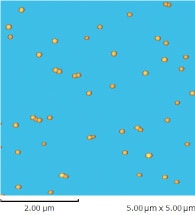
Height Image
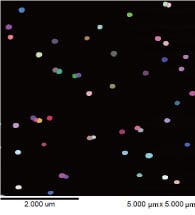
Fiber Isolation
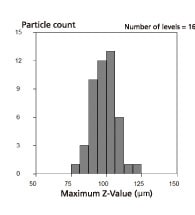
Histogram of Particle Size Distribution
Fiber Length Analysis of Cellulose Nanofibers
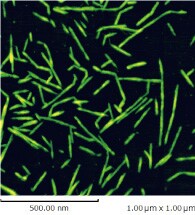
Height Image
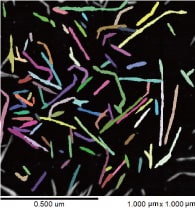
Fiber Isolation
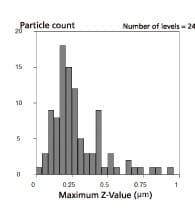
Histogram of Boundary Length Distribution
This allows isolating numerous nanoparticles and nanofibers from observation data and calculating their diameter, boundary length, or other characteristic quantities. Fiber length is calculated as half the boundary length. Because it can statistically determine characteristic quantities for numerous samples, it can also be used for shape-based quality control applications.
Characteristic Quantities
- Center of gravity X-coordinate
- Center of gravity Y-coordinate
- Absolute maximum diameter
- Pattern width
- Horizontal Feret diameter
- Vertical Feret diameter
- Circular radius (excluding holes)
- Circular radius (including holes)
- Mean radius
- Variability of mean radius
- Minimum distance between centers of gravity
- Boundary length
- Boundary length of convex hull
- Maximum Z-value
- Minimum Z-value
- Mean Z-value
- Mean Z-value of particle boundary
- Area excluding holes
- Area including holes
- Surface area
- Volume
- Pattern orientation
- Angle of principal 2D moment of inertia
- Volume ratio
- Area ratio
- Flatness
- Roundness
- Roughness
- Thinness
Statistical Quantities
- Mean
- Standard deviation
- Mean length
- Mean area
- Mean volume
- Total
- Maximum value
- Minimum Value
- Label number for maximum value
- Label number for minimum value
- Range
- Particle count
News / Events
-
Scanning Probe Microscope SPM-9700HT Plus has been released
Introducing the SPM-9700 HT Plus, Shimadzu's latest high-resolution scanning probe microscope designed to meet the most demanding surface analysis needs. This advanced instrument offers unparalleled precision and efficiency, featuring high-speed scanning, enhanced stability, user-friendly interface and versatile applications.
-
Explore the newly established SPM/AFM Solutions Plaza (formerly known as the SPM data room).
Discover images of observations and application news across various fields utilizing scanning probe microscopy/atomic force microscopy (SPM/AFM). Additionally, you can access a list of publications that highlight our SPM/AFM data.
-
Cellulose nanofibers
Given that cellulose nanofibers(CNFs)offer attractive physical characteristics, such as light weight, strength, and hardness, they not only enable materials with advanced functionality, but are expected to be used as a reinforcing material that can reduce the weight of composite materials.
-
Jewelry, Gemstone
Various instruments are used for the appraisal of precious stones. These instruments are not limited to general gemstone appraisal tools such as the stereoscopic microscope, but also include various analytical instruments.
-
Shimadzu has released the EDX-7200 Energy Dispersive X-ray Fluorescence Spectrometer
-
Shimadzu Introduces SPM-Nanoa Scanning Probe Microscope
Provides High-Level Operability and High-Speed Processing, with Automated Optical Adjustments and Observation Conditions Settings


